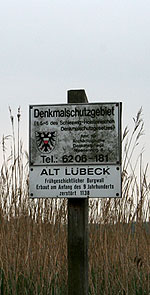Liubice
Liubice (= "the lovely one") was the slavian name of Old Luebeck, the
former settlement of today's Luebeck. It was located downstream the town island (Altstadt-Insel) about 6 km from today's town center where the river Schwartau flows into the Trave river.
In the 7th century slavian people advanced into the areas near the Lubeck bay left by the Germanic inhabitants during the peoples’ migration. The Wagrier and Polaben established a close network of villages and castles, among them Oldenburg (Starigard), Plön, Ratzeburg and later the residence of slavian kings called Liubice.
Starting from the middle of the 11th century a development of Liubice took place, which led to the foundation of a large settlement at the other river bank, consisting of a castle, a port, two fore-castle settlements and its own quarter of merchants developing around the merchants’ church.
Old Luebeck was destroyed in 1138 by the Ranen and given up afterwards as a commercial centre. In 1143 the count Adolf II. of Holstein transferred the name Liubice to his foundation of a town situated on a peninsula named Bucu, from which today's Luebeck came out.
First excavations in Old Luebeck already took place in 1851, the archaeological finds are shown among others in the Holstentor museum. Today you will find a soil monument, a memorial and an infoboard, which describes the location and expansion of the old settlement.
[Visit link: Wikipedia]
Due to the area of preservation the cache is not located near the soil monument, but about 100 meters apart. You will find a small plastic container; it is not necessary to walk across the nearby railroad track, you do not have to walk into the protected vegetation either.
Good luck and greetings,
Wikinger & Gutemiene
In the 7th century slavian people advanced into the areas near the Lubeck bay left by the Germanic inhabitants during the peoples’ migration. The Wagrier and Polaben established a close network of villages and castles, among them Oldenburg (Starigard), Plön, Ratzeburg and later the residence of slavian kings called Liubice.
Starting from the middle of the 11th century a development of Liubice took place, which led to the foundation of a large settlement at the other river bank, consisting of a castle, a port, two fore-castle settlements and its own quarter of merchants developing around the merchants’ church.
Old Luebeck was destroyed in 1138 by the Ranen and given up afterwards as a commercial centre. In 1143 the count Adolf II. of Holstein transferred the name Liubice to his foundation of a town situated on a peninsula named Bucu, from which today's Luebeck came out.
First excavations in Old Luebeck already took place in 1851, the archaeological finds are shown among others in the Holstentor museum. Today you will find a soil monument, a memorial and an infoboard, which describes the location and expansion of the old settlement.
[Visit link: Wikipedia]
Due to the area of preservation the cache is not located near the soil monument, but about 100 meters apart. You will find a small plastic container; it is not necessary to walk across the nearby railroad track, you do not have to walk into the protected vegetation either.
Good luck and greetings,
Wikinger & Gutemiene

Way to the soil monument

Memorial